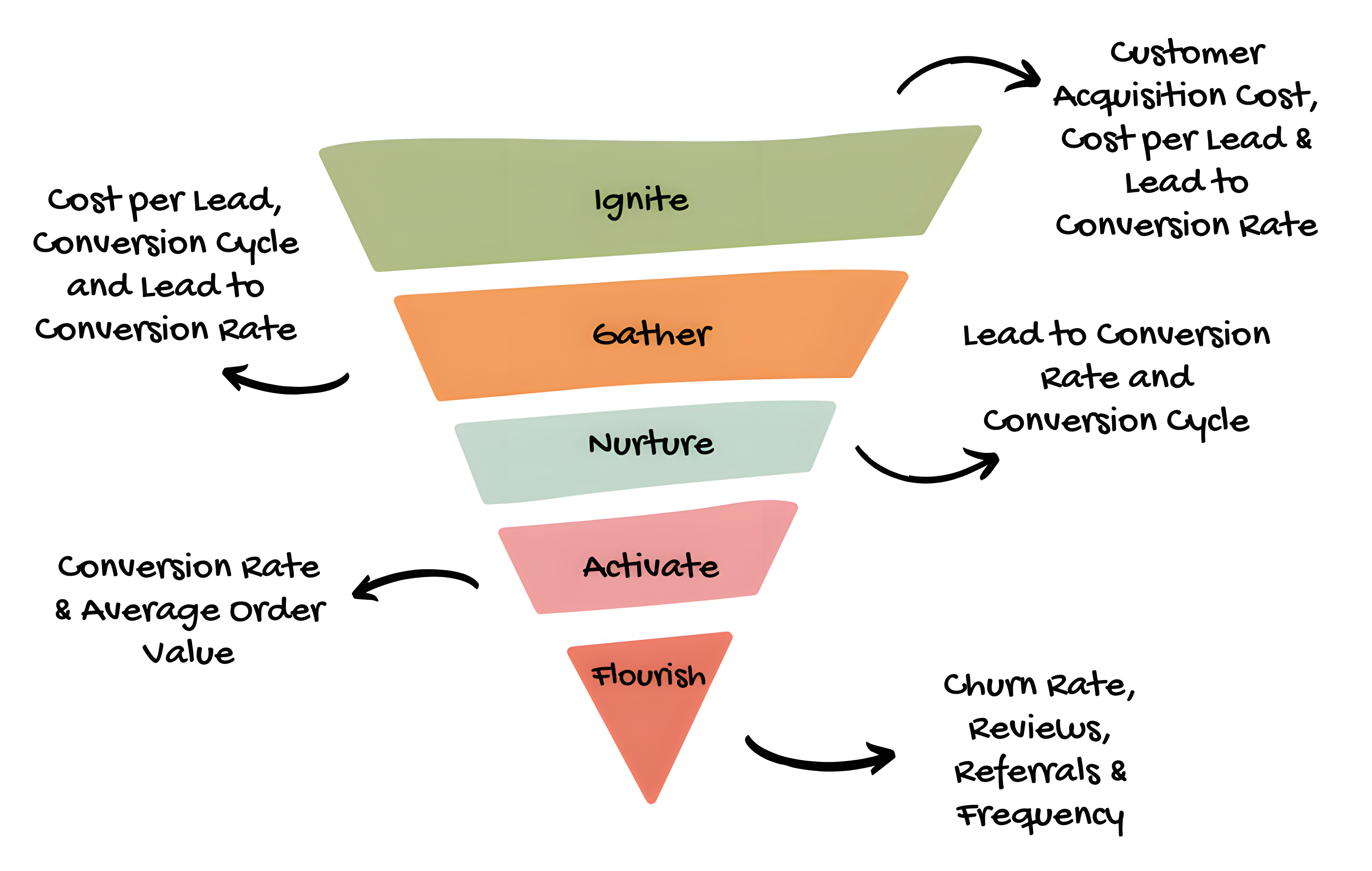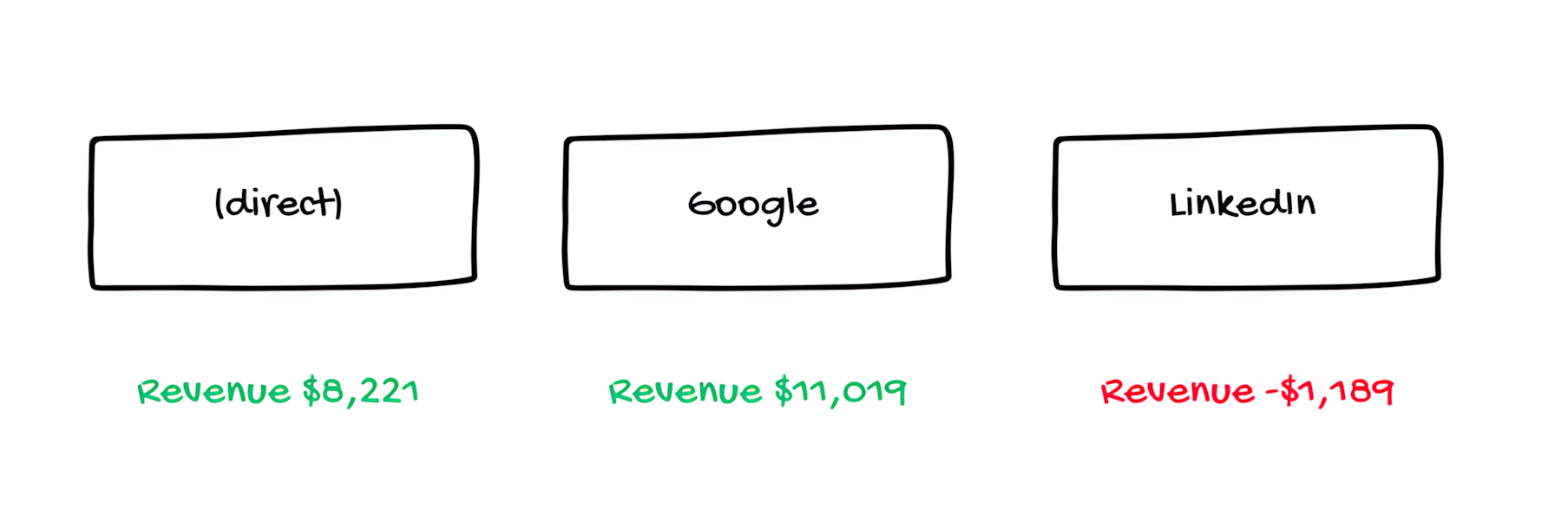In great extend I’ve written in the marketing intersection about the Prism model with it’s dedicated Key Performance Indicators.
Let’s take a look at it again.

The problem is of course, how do we keep track of all stages? And the honest answer is, you can’t. There is no software that does all of this. It’s impossible, there are just to many variables out there.
Every business is different. If one would create a software that does all of this, that fits for all businesses… it would probably have hundreds of thousands lines of code.
It’s always a marketing tech stack
For each stage there are dozens of software solutions out there. From web analytics, email marketing solutions to CRMs. All glued together to keep track of ones marketing.
Yet, the number one question among 99% of all entrepreneurs is, where do my customers come from? But the core problem, the root of the problem is actually a completely different one.
It’s about finding time and resources to effectively market your business.
And now we have another problem. How do you find the time and the resources to market your business? Preferably without going insane.
I’ve been looking for a solution to this fundamental problem. It doesn’t matter what business you run, in what industry you operate, what challenges you face, in the end — when we talk about marketing — you always have the issue of finding enough time and the needed resources to marketing your business.
The fallacy of analytics
Most entrepreneurs rely on numbers. Which is great. But what numbers do you use to make strategic decisions?
The visitors on your sites, the traffic, the bounce rate, the average time on your site? You may laugh, this is what I often hear. These people start to argue that if they can increase the average time on their site more people would buy.
In my opinion, they are all looking in the wrong direction. If your shop gets 100,000 visitors daily and no one buys, then you have a fundamental problem. Doesn’t matter the average time on your site, or bounce rate. Forget that.
Real metrics

Let’s talk about real metrics. Not vanity metrics like visitors, views, bounce rates, or whatever.
I am talking about numbers that translate into profits.
If you know these numbers, you gain two things: Efficiency and knowledge. With both we solve the underlying problem that is responsible for bad marketing decisions.
Finding the time and resources to effectively market your business.
When you know where your customers come from and what they’re worth, you don’t need to try dozens different strategies, you saved time. If you know where to invest more — based on numbers — you save resources.
This thought process was the reason why I have created an attribution platform that is based on what I’ve written so far about marketing and advertising here.
This software is based on the marketing intersection.
Know what works and what not
This was the goal. The only reason why I started to code this piece of software was to give you the clarity you need to find out what works for you and what not.
Most entrepreneurs try to wrap their head around all the different marketing strategies and when to use what. I often hear the learning curve is too steep and I lack the budget to throw at ads or hire an even more expensive marketing agency.
The result is unfortunately always the same.
You become overwhelmed by the sheer number of options and strategies available. So many different opinions circulate out there. While you must find out what works for you.
And this is now possible.
Designed to give you clarity
It’s simple and can be done in less than 5 minutes. You just create your account, add one script to your website and the basic configuration is done.
What’s left are two API calls that you need to call when you want to add a lead and/or purchase.
And the result?
You exactly see which channel brought in what revenue.
You see metrics that matter.
So you regain your time and resources to effectively market your business.
Now, let’s dive a bit deeper into this all.
Privacy Friendly Attribution
You add to your website our script, which looks like this
<script defer src="https://cdn.advertising.rocks/script.js" data-project-id=""></script>This script then hands out one cookie to each visitors of yours. Yes, your cookie banner needs to state that but(!) this cookie is not tied to any personally identifieable data.
In other words, the cookie itself is worthless. No IPs, User Agents or fingerprints are tied to it, nor is such data ever saved.
Only when this visitor becomes a lead or/and purchases from you, you can save personal data. Can?
Itself our platform is fully GDPR compliant because fundamentally no personal data is saved. You don’t need to add email or name to the leads you track. Nor to the purchases, but you can if you want.
Just make sure to tell your visitors about that.
Leads
Let’s say you sell a software that holds a free trial. Naturally you have leads.
This is how you can keep track of them, plus their origin.
await fetch('https://api.advertising.rocks/v1/leads', {
method: "POST",
headers: {
"Content-Type": "application/json",
"Authorization": "YOUR_KEY",
}
});You see, no personal data. You can however add a payload to this call and save their email and name.
Purchases
Now, sooner or later this lead may buy. You can track this event by using this code.
await fetch('https://api.advertising.rocks/v1/purchases', {
method: "POST",
headers: {
"Content-Type": "application/json",
"Authorization": "YOUR_KEY",
}
});The best part of this is, you don’t need an underlying lead to track purchases. It’s up to you, if you want to track leads or not.
From a marketing standpoint, you should. But hey, however you like it.
You see what channel works

Plus, in total eight metrics.
- Lifetime Customer Value
- Purchase Frequency
- Customer Acquisition Cost
- Cost per Lead
- Lead to Conversion Rate
- Conversion Cycle
- Average Order Value
- Return on Ad Spend
(Again, please refer to this article if you are unsure about any of these metrics)
What’s the result? Only knowing revenue is in my opinion not enough. Strategic decisions can only be made if you know your numbers, as we already talked about in other articles.
This was also the key motivation of this software. To equip you with the numbers — on autopilot — so you can make smarter decisions in matter of hours and not days.
If you’re interested, you can head over to app.advertising.rocks to create your own account. The first fourteen days are on me. Then it starts at $15 per month excl. taxes.